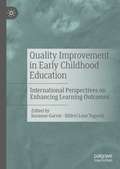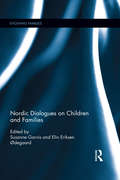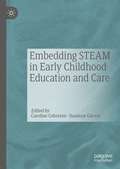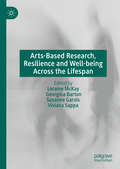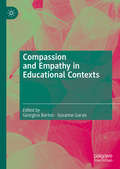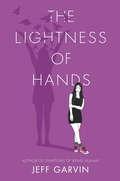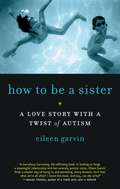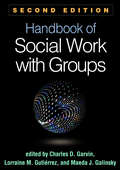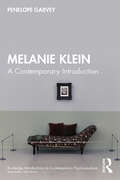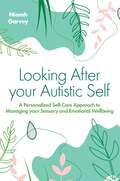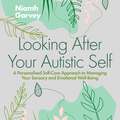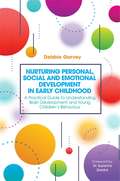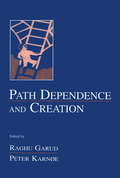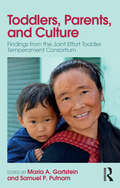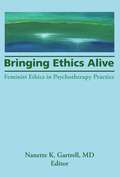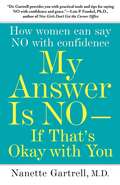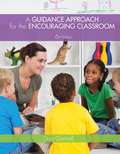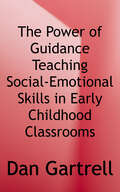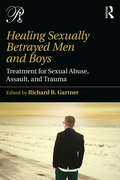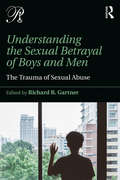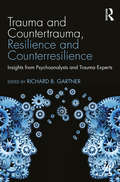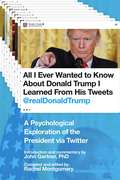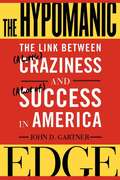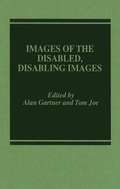- Table View
- List View
Quality Improvement in Early Childhood Education: International Perspectives on Enhancing Learning Outcomes
by Susanne Garvis Hillevi Lenz TaguchiThis book explores international perspectives on quality improvement within the field of early childhood education and care. Many countries and governments are focusing on preschool quality as a way to improve entrenched inequalities and reduce social disadvantage and segregation: this book draws together various global case studies to showcase how different countries tackle aspects of quality improvement. The concept of quality is understood in different ways both culturally and contextually, and the implementation of measures to improve quality will differ from country to country. The book draws together case studies from numerous contexts to showcase various ways of working with aspects of quality improvement. Sharing important insights into policy and practice, this book guides a shared understanding of the complex nature of quality improvement within early childhood education and care.
Nordic Dialogues on Children and Families (Evolving Families)
by Susanne Garvis Elin Eriksen ØdegaardThis book brings together key authors from the Nordic countries (Sweden, Finland, Norway, Denmark and Iceland) to discuss theoretical and empirical research on families and children. Sharing the Nordic perspective from each of the five countries, the book highlights key ideas within and across the countries. The chapters provide an understanding of the history of the Nordic perspectives of family and children, present current innovative research on solutions to complex issues, and explore contemporary issues. Nordic countries continually attain high scores in lifestyle measures, quality of life and children’s outcomes. Much of this has to do with the specific culture and policy of the Nordic countries. Written by academics within the region who are well regarded for contributing to academic and public debate, this book will appeal to an international audience interested in the Nordic perspective and social policy around family and children.
Embedding STEAM in Early Childhood Education and Care
by Susanne Garvis Caroline CohrssenThis book approaches STEAM (Science, Technology, Engineering, the Arts and Mathematics) in early childhood education from multiple angles. It focuses on the teaching and learning of children from two years of age to the early years of school. Proponents of STEAM describe how it can create opportunities for children to learn creatively, and various chapter authors make strong connections between discipline areas within the context of an informal curriculum. Others advocate for an integrated STEM, rather than STEAM, approach. With a light touch on theory and a focus on how to embed STE(A)M in an integrated early childhood curriculum, the editors and contributors examine the STEAM versus STEM question from multiple angles. The chapters provide helpful frameworks for parents, teachers and higher education institutions, and make practical suggestions of ways to support young children’s inquiry learning. Drawing on pedagogy and research from around the world, this book will be of interest to scholars of STEAM education, early childhood educators, students of early childhood education and parents of young children.
Arts-Based Research, Resilience and Well-being Across the Lifespan
by Susanne Garvis Georgina Barton Loraine McKay Viviana SappaThis book investigates how arts-based research methods can positively influence people’s resilience and well-being, particularly in constraining environments. Using examples from arts-based research methods in different contexts and from across the globe, the book brings together a diverse range of perspectives to understand how both resilience and well-being can be supported in a world that is rarely stress free. Collectively they demonstrate how arts-based research methods can: provide agency through the foregrounding of participants’ voices; afford transformational learning opportunities; create opportunities for relationship building; support creativity and new ways of thinking; generate aspirations and hope; encourage forms of communication that expose ideas, emotions and feelings that previously might not have been known or known how to be expressed; and enhance reflection and reflexivity. The authors explore how art-based practices, such as clowning, collage, dramatisation, drawing, painting, role-play and sculpting, can be used to support the resilience and well-being of individuals and groups across the lifespan, and theorize how arts-based research methods can positively contribute to participants’ positive self-esteem, self-image and ability to cope with challenges and new circumstances. Academics, professional learning facilitators, higher education students, and anyone interested in resilience and well-being in the health and education sectors will find this an interesting and engaging text.
Compassion and Empathy in Educational Contexts
by Susanne Garvis Georgina BartonThis book explores the importance of compassion and empathy within educational contexts. While compassion and empathy are widely recognised as key to living a happy and healthy life, there is little written about how these qualities can be taught to children and young people, or how teachers can model these traits in their own practice. This book shares several models of compassion and empathy that can be implemented in schooling contexts, also examining how these qualities are presented in children’s picture books, films and games. The editors and contributors share personal insights and practical approaches to improve both awareness and use of compassionate and empathetic approaches to others. This book will be of interest and value to all those interested in promoting compassion and empathy within education.
The Lightness of Hands
by Jeff GarvinA quirky and heartfelt coming-of-age story about a teen girl with bipolar II who signs her failed magician father up to perform his legendary but failed illusion on live TV in order to make enough money to pay for the medications they need—from the author of Symptoms of Being Human. Perfect for fans of Adi Alsaid, David Arnold, and Arvin Ahmadi. Sixteen-year-old Ellie Dante is desperate for something in her life to finally go right. Her father was a famous stage magician until he attempted an epic illusion on live TV—and failed. Now Ellie lives with her dad in a beat-up RV, attending high school online and performing with him at birthday parties and bars across the Midwest to make ends meet.But when the gigs dry up, their insurance lapses, leaving Dad’s heart condition unchecked and forcing Ellie to battle her bipolar II disorder without medication.Then Ellie receives a call from a famous magic duo, who offer fifteen thousand dollars and a shot at redemption: they want her father to perform the illusion that wrecked his career—on their live TV special, which shoots in Los Angeles in ten days. Ellie knows her dad will refuse—but she takes the deal anyway, then lies to persuade him to head west. With the help of her online-only best friend and an unusual guy she teams up with along the way, Ellie makes a plan to stage his comeback. But when her lie is exposed, she’ll have to confront her illness and her choices head-on to save her father—and herself.
How to Be a Sister: A Love Story with a Twist of Autism
by Eileen GarvinEileen Garvin's older sister, Margaret, was diagnosed with severe autism at age three causing awkward, hilarious, and heartbreaking situations. What is she going to do about Margaret? Will she remain in Margaret's life, or walk away? How to Be a Sister will speak to siblings, parents, friends, and teachers of people with autism and to anyone who sometimes struggles to connect with someone difficult or different.
Handbook of Social Work with Groups, Second Edition
by Charles D. Garvin Lorraine M. Gutiérrez Maeda J. GalinskyThis definitive text, now revised and expanded, has introduced thousands of students and practitioners to the theory and practice of social work with groups. Leading authorities outline major models of group work and address critical issues in planning, implementing, and evaluating interventions. The Handbook describes applications in all the major practice settings--mental health, prevention, child welfare, substance abuse, health care, aging, corrections, and more--as well as organizational and community settings. A strong focus on empowerment, social justice, and diversity is woven throughout. The empirical foundations of group work are reviewed, and innovative research methods discussed. New to This Edition: *Incorporates over a decade of advances in the field *Heightened focus on practitioner-researcher collaboration. *Two chapters on substance abuse prevention with youth. *Chapters on social justice work, evidence-based practice, offender reentry, intimate partner violence, intergroup dialogue, working with immigrants and refugees, qualitative methods, and intervention research. *Major updates on existing topics, such as cognitive-behavioral group work, psychoeducational groups, health care settings, and technology-mediated groups. *Integrative epilogue that synthesizes key themes.
Melanie Klein: A Contemporary Introduction (Routledge Introductions to Contemporary Psychoanalysis)
by Penelope GarveyThis important book provides a concise introduction to Melanie Klein and the key concepts and theories she founded, outlining their application to psychoanalytic technique, and explaining how her ideas have been further developed. As Klein’s ideas have opened the exploration of deeper and more primitive areas of the mind, they have led to extensive theoretical and technical developments across the world, in various schools of psychoanalytic thought. This book addresses Klein’s early papers on her work with children and her extensions of Freud’s ideas, as well as her divergence from them, highlighting Klein’s emphasis on loving relationships in the mitigation of hatred, in children’s overall development and in the drive for reparation. Examples from Klein’s clinical work with children and adults are included to illustrate and illuminate her points. Offering clear expositions of complex concepts and linking to more detailed sources of information, this book is important reading for all clinicians, trainees and students interested in emotional development and in the analysis of children and adults.
Looking After Your Autistic Self: A Personalised Self-Care Approach to Managing Your Sensory and Emotional Well-Being
by Niamh Garvey'I no longer try to mask my autism; I now work to support my autism'It is a myth that autistic children grow into 'less autistic' adults. In fact, many autistic adults feel more overwhelmed as they age as the stresses of social demands such as relationships, parenting, or the work environment increase.Niamh Garvey offers tips and tricks designed to reduce sensory and emotional stress and look after your autistic self. From understanding what's happening when the stress response kicks in to using the 'detective habit' to spot your individual strengths and triggers. What's more, every element of this book can be personalised to you.Featuring strategies including 'quick calm plans' for managing triggers and lived-experience advice on understanding emotional regulation, coping with sensory overload and how to look after your senses during intimacy, this guide is here to ensure that you don't just survive adulthood, you thrive in it.
Looking After Your Autistic Self: A Personalised Self-Care Approach to Managing Your Sensory and Emotional Well-Being
by Niamh Garvey'I no longer try to mask my autism; I now work to support my autism'Take charge of your needs including sensory self-care and emotional regulation for a calmer and happier life.It is a myth that autistic children grow into 'less autistic' adults. In fact, many autistic adults feel more overwhelmed as they age as the stresses of social demands such as relationships, parenting, or the work environment increase.Niamh Garvey offers tips and tricks designed to reduce sensory and emotional stress and look after your autistic self. From understanding what's happening when the stress response kicks in to using the 'detective habit' to spot your individual strengths and triggers. What's more, every element of this book can be personalised to you.Featuring strategies including 'quick calm plans' for managing triggers and lived-experience advice on understanding emotional regulation, coping with sensory overload and how to look after your senses during intimacy, this guide is here to ensure that you don't just survive adulthood, you thrive in it.(P)2023 Hodder & Stoughton Limited
Nurturing Personal, Social and Emotional Development in Early Childhood: A Practical Guide to Understanding Brain Development and Young Children’s Behaviour
by Debbie Garvey Dr Suzanne ZeedykThis direct guide supports practitioners in nurturing personal, social and emotional development (PSED) in young children by demystifying brain development research. Condensing a wealth of recent research and theory around PSED into practical guidance, it gives professionals the knowledge and understanding they need to critically evaluate their own practice and find the best course of action to support PSED in young children. From the perspective of neuroscience, it explores what can help or hinder development, considers why some children bite and why toddlers have tantrums, and questions how well-intentioned actions, such as reward systems or putting new foods on a plate for children to 'just try', may be misguided.
Path Dependence and Creation (Organization and Management Series)
by Raghu Garud Peter KarnøeThe editors, aware of the recent work in evolutionary theory and the science of chaos and complexity, challenge the sometimes deterministic flavor of this subject. They are interested in uncovering the place of agency in these theories that take history so seriously. In the end, they are as interested in path creation and destruction as they are in path dependence. This book is compiled of both theoretical and empirical writings. It shows relatively well-known industries, such as the automobile, biotechnology, and semi-conductor industries in a new light. It also invites the reader to learn more about medical practices, wind power, lasers, and synthesizers. Primarily written for academicians, researchers, and Ph.D. students in fields related to technology management, this book is research-oriented and will appeal to all managers.
Toddlers, Parents and Culture: Findings from the Joint Effort Toddler Temperament Consortium
by Maria A. Gartstein Samuel P. PutnamOne doesn’t have to travel extensively to realize that there are intriguing differences in the ways in which people from different cultures tend to behave. Gartstein and Putnam explore whether these differences are shaped during the early years of life, at the moment when children are just beginning to understand how, when, and why they should express some emotions, and not others. Based on the findings of the Joint Effort Toddler Temperament Consortium (JETTC), which asked parents from 14 different countries multiple questions regarding their main goals and techniques for raising children to be successful in their culture, Gartstein and Putnam analyze how children’s characteristics (both normative and problematic) are shaped by different cultural environments. Drawing from insights in anthropology, sociology, and developmental psychology, the book explores the full spectrum of human experience, from broad sets of values and concerns that differentiate populations down to the intimate details of parent-child relationships. The results reveal a complex web of interrelations among societal ideals, parental attempts to fulfill them, and the ways their children manifest these efforts. In doing so, they provide a revealing look at how families raise their young children around the world. Toddlers, Parents, and Culture will be of great interest to students and scholars in temperament, cross-cultural psychology, parenting and socioemotional development in early childhood, as well as professionals in early education, child mental health, and behavioral pediatrics.
Bringing Ethics Alive: Feminist Ethics in Psychotherapy Practice
by Nanette GartrellGain fresh theoretical and practical perspectives of feminist ethics in psychotherapy from this groundbreaking book. The combined effect of increases in the population of minorities in the U.S. and the number of women in psychotherapy practice will have great impact on the future of the mental health profession. Psychotherapy practitioners and students must learn how to make ethical considerations concerning gender, ethnicity, and sexual orientation. Bringing Ethics Alive is the only book of its kind that deals with the multicultural aspects of ethics in mental health services and discusses specific objectives for incorporating ethics in psychotherapy education.Divided into two sections, Bringing Ethics alive focuses on both theoretical and practical issues of ethics in feminist therapy. The first section addresses theory by emphasizing the ethical responsibility of training programs to incorporate discussions on issues of racism, sexism, and heterosexism into the curricula. The important principles that should be included in courses on ethics in psychotherapy are outlined and include in-depth explanations of the ethics of confidentiality, professional competence, and conflicts of interest. A model for reconceptualizing boundary definitions in therapy is also provided.The second half of Bringing Ethics Alive provides insights on a wide range of ethical considerations in psychotherapy practice. Some of the specific issues discussed include: sexual abuse of clients by women therapists experiences of women sexually abused by male therapists compared to women sexually abused by female therapists a personal account of sexual misconduct in therapy from the point of view of the victim the ethics code of the Feminist Therapy Institute and the difficulties in translating the code into practice the inappropriate use of Native American spiritual practices or activities by non-Native American professionalsGraduate students in psychology, social work, and counseling, psychiatric residents, psychologists, social workers, counselors, and counseling clergy, no matter what their level of experience, will benefit from this thought-provoking exploration of feminist ethics in theory and practice. With its multicultural viewpoint and clear definitions of ethical issues, Bringing Ethics Alive is an essential book for helping mental health professionals sort through the complex issues of ethics in feminist therapy.
My Answer is No . . . If That's Okay with You: How Women Can Say No and (Still) Feel Good About It
by Nanette GartrellAre you afraid you'll hurt the people you care about if you say NO to them? Can you set limits when employees neglect their responsibilities? How about with your boss? When friends ask you to do something you don't want to do, do you invent an elaborate excuse? Do you have a hard time saying NO to an invitation even when you're completely exhausted? Do you have trouble even practicing the sentence "No, Mom, I just can't make it home this holiday"? If any of these scenarios sound familiar, keep reading - you need this book... No is a very simple word -- two letters, one syllable. Yet many women have a hard time saying it without feeling anxious or guilty. In My Answer Is NO...If That's Okay with You, award-winning psychiatrist and author Dr. Nanette Gartrell takes a fresh look at why even the most powerful, accomplished, and successful women find it difficult to say no and offers a revolutionary approach to setting limits without jeopardizing important relationships. Today women are bombarded with messages like "put yourself first" and "stop being a people-pleaser." But this sort of advice is useless to women who value the caring and generosity that prompt them to say yes in the first place. Through personal interviews with a diverse group of talented women, including CEOs, celebrities, physicians, and public officials, Dr. Gartrell shows that women's reluctance to say no stems from valuable traits that they should embrace, such as empathy, sensitivity, and thoughtfulness. With humor and wisdom, Dr. Gartrell reaffirms the psychological importance of compassion and feeling connected, which can often lead a woman to say yes rather than no in order to preserve a relationship or spare someone's feelings. Through entertaining anecdotes and insights from her years of clinical practice, Dr. Gartrell teaches women to honor their best instincts while still maintaining boundaries. My Answer Is NO...If That's Okay with You offers creative, practical ways to transform an automatic or reluctant yes into a healthy, respectful no -- and still feel good about it.
A Guidance Approach for the Encouraging Classroom
by Dan GartrellA GUIDANCE APPROACH FOR THE ENCOURAGING CLASSROOM, 5/E, is for students in two- and four-year early childhood programs as well as graduate courses. It easily can function as a primary text in classes that address group management, the learning environment, child guidance, child behavior, challenging behavior, conflict management, and peace education topics. The text addresses ages 3 - 8 years in three parts. Part 1 explores the foundation of guidance in early childhood education and covers key concepts such as conventional discipline versus guidance, mistaken behavior, the guidance tradition, and innovative theories about child development with guidance. Part 2 focuses on building and organizing an encouraging classroom, as well as providing key elements of an encouraging classroom, including daily schedule, routines, use of thematic instruction, importance of working with parents, and leadership communication. Part 3 addresses problem solving and challenging behavior in the encouraging classroom, including a practical illustration for how to use and teach conflict management and coverage of the five-finger-formula. The book also covers nontraditional families as well as the effects of societal violence in the classroom. Throughout, this experience-based resource includes real-life anecdotes that allow professionals to make the shift from conventional classroom to developmentally appropriate guidance.
The Power of Guidance: Teaching Social-emotional Skills in Early Childhood Classrooms
by Dan GartrellChildcare providers and teachers in preschool and primary grade settings will greatly value the collection of writings in The Power of Guidance: Teaching Social-Emotional Skills In the Early Childhood Classroom. The writings provide a concise yet multi-faceted overview of the guidance approach used with this age group. The book examines the differences between patience and understanding and between misbehavior and mistaken behavior, important distinctions that must be made in order to understand and deal with various behaviors using the guidance approach. Readers also will learn the components of an encouraging classroom and strategies for maintaining it, leading to non-punitive approaches for classroom management. One chapter puts particular focus on intervention strategies with boys, a topic readers often seek out. The book has the distinction of being selected as a comprehensive member benefit for the NAEYC for 2003.
Healing Sexually Betrayed Men and Boys: Treatment for Sexual Abuse, Assault, and Trauma (Psychoanalysis in a New Key Book Series)
by Richard B. GartnerHealing Sexually Betrayed Men and Boys: Treatment for Sexual Abuse, Assault, and Trauma is the new authoritative source for treatment of sexually victimized men and boys. Male victims and survivors of sexual trauma lived in shadow until the turn of the 21st century, when scandal after scandal about the sexual abuse of boys and men shed light on their suffering. These men and boys require different treatment roadmaps than their female counterparts. Yet there is little in the professional literature to help a clinician work with sexually traumatized boys and men. Richard B. Gartner is a seasoned psychologist/psychoanalyst who has worked therapeutically with sexually abused men for over three decades. He is a clinician, advocate, teacher, lecturer, and nationally and internationally recognized expert on the subject. Dr. Gartner’s classic book, Betrayed as Boys: Psychodynamic Treatment of Sexually Abused Men, is one of the few written to guide clinicians. Now, nearly two decades after writing that groundbreaking volume, he follows up on his earlier work. Healing Sexually Abused Men and Boys, together with its companion volume, Understanding the Sexual Betrayal of Boys and Men, is a thorough, comprehensive guide to learning about and healing male victims and survivors. Dr. Gartner has invited a group of experts to write about specific problems faced by these boys and men. Specialists from the psychoanalytic, psychodynamic, trauma, and legal worlds fill in the details about a wide range of interconnected subjects related to the complex reverberations of male sexual trauma. Healing Sexually Betrayed Men and Boys covers such diverse topics as: therapy with young sexually traumatized boys; the aftermath for men who were raped as adults ; covert seduction of boys and its aftereffects; treatment for substance addictions and sexual compulsions; couples work with male survivors and their partners or spouses; bodywork with male survivors; treatment for male veterans who suffered sexual trauma in the military; profiling sexual predators and working with survivors who have also been sexual predators. This book is a valuable resource for clinicians at every level of training. With strategies for how survivors can build support networks and descriptions of clinical, familial, and community-based treatments, Healing Sexually Betrayed Men and Boys is essential reading for clinicians of all theoretical persuasions who work with male sexual abuse survivors. Filling in gaps in the relatively scant literature on the subject, it will also help sexually abused or assaulted men themselves understand what is available to them.
Understanding the Sexual Betrayal of Boys and Men: The Trauma of Sexual Abuse (Psychoanalysis in a New Key Book Series)
by Richard B. GartnerUnderstanding the Sexual Betrayal of Boys and Men: The Trauma of Sexual Abuse is an indispensable go-to book for understanding male sexual victimization. It has become increasingly clear since the 1980s that men and boys, like women and girls, are sexually abused and assaulted in alarming numbers. Yet there have been few resources available to victims, their loved ones, or those trying to help them. Richard B. Gartner was in the vanguard of clinicians treating male sexual victimization and has written extensively about it, initially in professional papers, then in his landmark 1999 book for clinicians Betrayed as Boys: Psychodynamic Treatment of Sexually Abused Men, continuing with his 2005 work Beyond Betrayal: Taking Charge of Your Life after Boyhood Sexual Abuse. He has been a tireless teacher, clinician, and advocate for male victims of sexual abuse in the classroom, the lecture hall, and of course the consulting room as well as in newspaper, television, radio, and online interviews. Dr. Gartner has gathered together expert colleagues from the trauma, psychoanalytic, medical, and survivor treatment fields. Together, they have created a comprehensive guide to what was once thought to be a rarity but now is clearly an all-too-common occurrence. Understanding the Sexual Betrayal of Boys and Men looks at the realities of male sexual victimization, guiding clinicians and lay people alike to understand the complexities of the devastation it causes in victimized boys and men. It considers topics as diverse as: sexual assault in institutions like the military, sports teams, schools, universities, and religious organizations; sex trafficking of boys and adolescents; neurobiology and brain chemistry of male survivors of sexual abuse; gender and sexual dysfunctions and confusions resulting from sexual exploitation and trauma; physicians’ treatment of sexually abused men’s medical problems; socio-cultural influences on processing and treating men’s and boys’ sexual victimization. Understanding the Sexual Betrayal of Boys and Men is required reading for anyone working with male victims of sexual abuse and assault at any level – psychotherapists, rape counselors, attorneys, journalists, guidance counselors, physicians, clergy, graduate students, and lawmakers – and helpful to lay people interested in this often-unrecognized problem.
Trauma and Countertrauma, Resilience and Counterresilience: Insights from Psychoanalysts and Trauma Experts (Psychoanalysis in a New Key Book Series)
by Richard GartnerTreating traumatized patients takes its toll on the treating clinician, giving rise over time to what Richard B. Gartner terms countertrauma in the psychoanalyst or therapist. Paradoxically, a clinician may also be imbued with a sense of optimism, or counterresilience, after learning how often the human spirit can triumph over heartbreakingly tragic experiences. Trauma and Countertrauma, Resilience and Counterresilience brings together a distinguished group of seasoned clinicians, both trauma specialists and psychoanalysts. Their personal reflections show what clinicians all too rarely dare to reveal: their personal traumatic material. They then discuss how they develop models for acknowledging, articulating, and synthesizing the countertrauma that arises from long-term exposure to patients’ often-harrowing trauma. Writing openly, using viscerally affecting language, the contributors to this exceptional collection share subjective and sometimes intimate material, shedding light on the inner lives of people who work to heal the wounds of psychic trauma. By the same token, many of these clinicians describe how working intimately with traumatized individuals can affect the listener positively, recounting how patients’ resilience evokes counterresilience in the therapist, allowing the clinician to benefit from ongoing contact with patients who deal bravely with horrific adversity. Paradoxically, a clinician may be imbued with a sense of optimism after learning how often the human spirit can triumph over heartbreakingly tragic experiences. Trauma and Countertrauma, Resilience and Counterresilience will appeal to psychoanalysts, psychoanalytic psychotherapists, and trauma experts, offering a valuable resource to those beginning their careers in mental health work, to teachers and supervisors of trauma therapists, to experienced clinicians struggling with burnout, and to anyone who wants to understand the psychotherapeutic process or indeed the human condition.
All I Ever Wanted to Know about Donald Trump I Learned From His Tweets: A Psychological Exploration of the President via Twitter
by John Gartner Rachel MontgomeryWe had to figure that by electing a decidedly non-career-politician, that things would be… different. But is this any way to run a country? Many opinions have been shared about Donald Trump, but we can learn so much more about the man via what he himself says – in 140 characters or less. Trump has tweeted nearly 35,000 times since launching @realDonaldTrump in March 2009, commenting on everything from immigration to policy climate change to even pop culture. As President, Trump tweets without ceasing, sometimes a dozen times a day, seemingly during important events and meetings. Apparently he believes that twitter is an effective tool for him to drive his agenda. But it’s one thing to be a brash, bold, and outspoken, maverick businessman, it’s quite another when the leader of the most powerful country in the world is talking politics as stream of consciousness.
The Hypomanic Edge
by John D. GartnerWhy is America so rich and powerful? The answer lies in our genes, according to psychologist John Gartner. Hypomania, a genetically based mild form of mania, endows many of us with unusual energy, creativity, enthusiasm, and a propensity for taking risks. America has an extraordinarily high number of hypomanics -- grandiose types who leap on every wacky idea that occurs to them, utterly convinced it will change the world. Market bubbles and ill-considered messianic crusades can be the downside. But there is an enormous upside in terms of spectacular entrepreneurial zeal, drive for innovation, and material success. Americans may have a lot of crazy ideas, but some of them lead to brilliant inventions. Why is America so hypomanic? It is populated primarily by immigrants. This self-selection process is the boldest natural experiment ever conducted. Those who had the will, optimism, and daring to take the leap into the unknown have passed those traits on to their descendants. Bringing his audacious and persuasive thesis to life, Gartner offers case histories of some famous Americans who represent this phenomenon of hypomania. These are the real stories you never learned in school about some of those men who made America: Columbus, who discovered the continent, thought he was the messiah. John Winthrop, who settled and defined it, believed Americans were God's new chosen people. Alexander Hamilton, the indispensable founder who envisioned America's economic future, self-destructed because of pride and impulsive behavior. Andrew Carnegie, who began America's industrial revolution, was sure that he was destined personally to speed up human evolution and bring world peace. The Mayer and Selznick families helped create the peculiarly American art form of the Hollywood film, but familial bipolar disorders led to the fall of their empires. Craig Venter decoded the human genome, yet his arrogance made him despised by most of his scientific colleagues, even as he spurred them on to make great discoveries. While these men are extraordinary examples, Gartner argues that many Americans have inherited the genes that have made them the most successful citizens in the world.
Images Of The Disabled, Disabling Images
by Alan Gartner Tom JoeThe first book of its kind, Images of the Disabled/Disabling Images combines an examination of the presentation of persons with disabilities in literature, film, and the media with an analysis of the ways in which these images are expressed in public policy concerning the disabled. <P><P> Leaders of the disability rights movement and major scholars of disability issues explore both attitudes toward the disabled, as well as the ways in which the disabling images of these attitudes are incorporated in employment, health, housing, and education policies. <P><P>Discussions include the appeal of new technological aids and new developments in community living. The first book of its kind, Images of the Disabled/Disabling Images combines an examination of the presentation of persons with disabilities in literature, film, and the media with an analysis of the ways in which these images are expressed in public policy concerning the disabled. Leaders of the disability rights movement and major scholars of disability issues explore both attitudes toward the disabled, as well as the ways in which the disabling images of these attitudes are incorporated in employment, health, housing, and education policies. Discussions include the appeal of new technological aids and new developments in community living.
Images of the Disabled, Disabling Images
by Alan Gartner Tom JoeIn this collection of a dozen essays, writers with strong backgrounds in the disability rights movement examine the roots of public attitudes toward the disabled. Several essays consider portrayals of people with disabilities in literature, film, and journalism. Others explore social policy toward the disabled in education, employment, and health-care. Nat Hentoff's powerful piece, ""The Awful Privacy of Baby Doe," expresses the author's outrage over the case of a child born with spina bifida who was denied treatment because doctors persuaded her parents that she would be better off dead.
